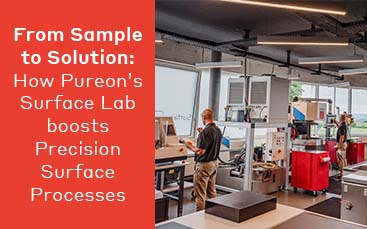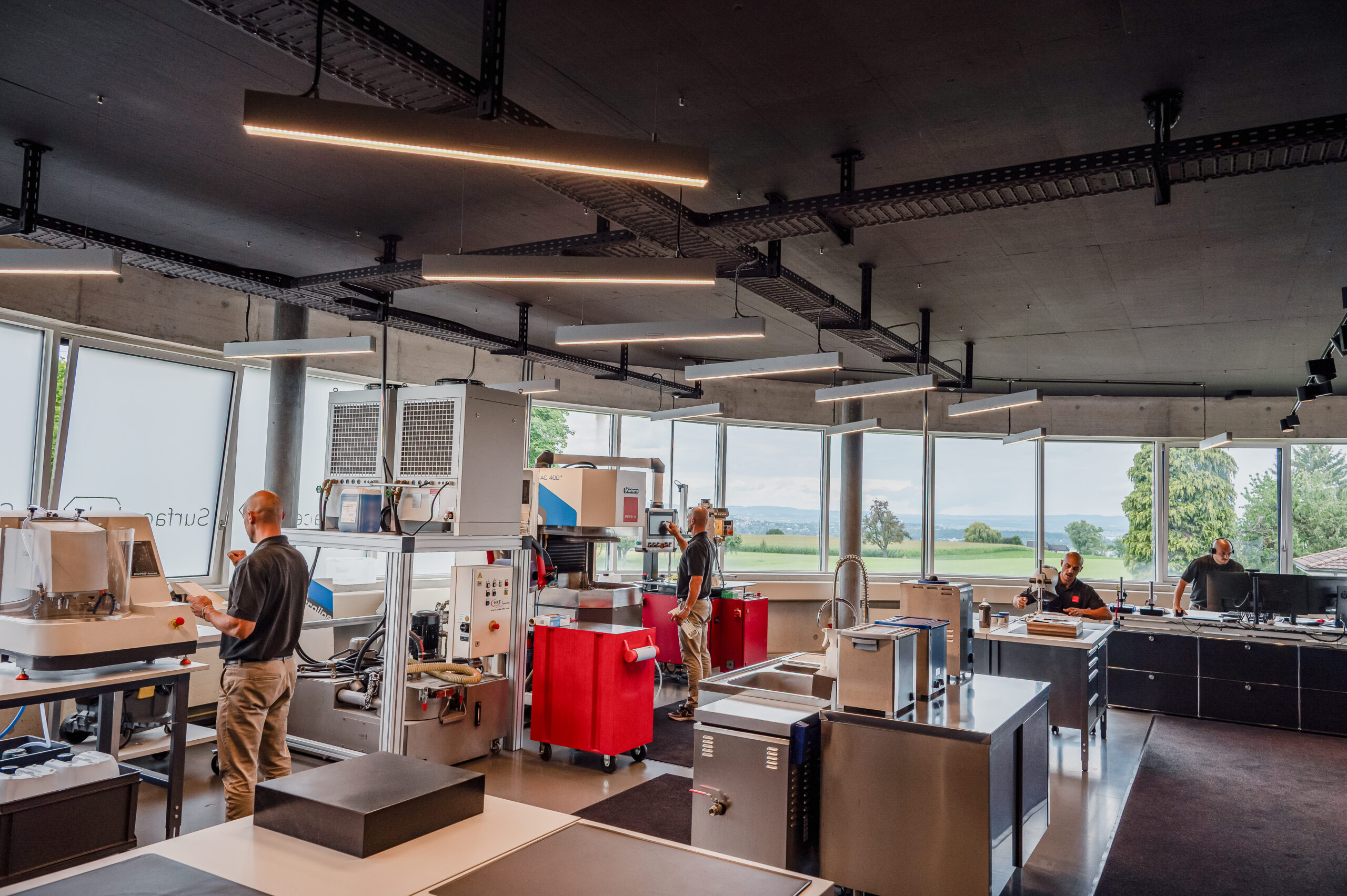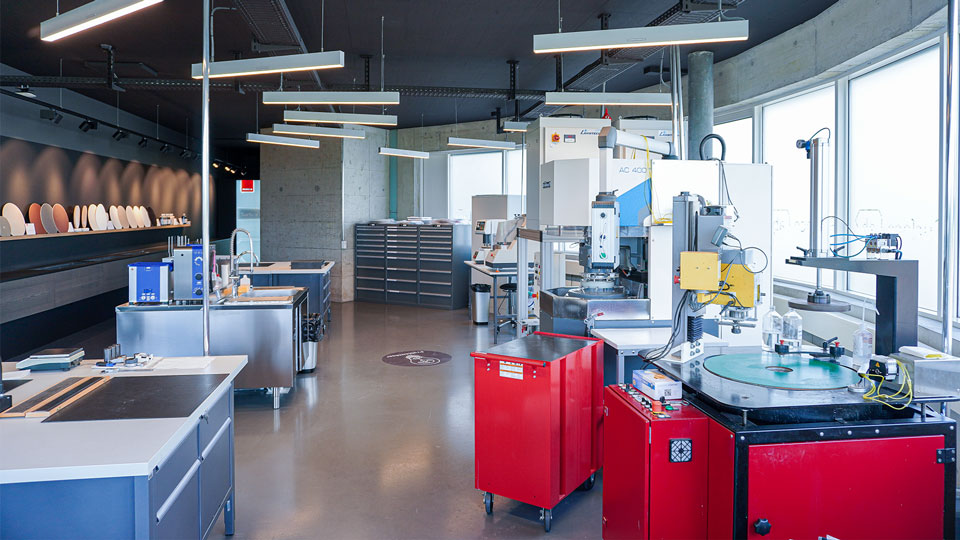From Sample to Solution: How Pureon’s Surface Lab boosts Precision Surface Processes
- Blog
- Insights
-
Sep 04
- Share post

From Sample to Solution: How Pureon’s Surface Lab boosts Precision Surface Processes

Validation. Optimization. Implementation — without interrupting the production line.
In high-precision manufacturing, surface quality directly affects yield, reliability, and performance. However, modifying or validating processes mid-production can cause costly disruptions. Pureon’s Surface Lab in Lengwil, Switzerland provides a fully controlled offline environment to replicate real-world process conditions. These include slurry chemistry, pad mechanics, pressure regimes, and material interactions. This enables in-depth validation, troubleshooting, and parameter optimization. By doing so, we ensure that any adjusted process is robust and fully production-ready before deployment.
“In our Surface Lab, we develop customized, application-specific solutions for all requirements in precise surface finishing – including grinding, lapping, as well as mechanical and chemical polishing – together with our customers, driven by deep technical expertise and passion”, says Sergio Phommara, Application Engineer at Pureon. This approach aligns with industry best practices. Process scale-up can often be most effective when conducted in isolated, offline environments to preserve critical process knowledge during the transition from lab to production (Gillenwater, 2024).

Technical Capabilities Rooted in Precision
The Surface Lab is equipped with a comprehensive range of processing and analytical tools, enabling controlled experimentation across multiple surface technologies:
- Single and double-sided polishing and lapping platforms for hard and brittle materials (SiC, sapphire, quartz, optical glass, advanced ceramics)
- Advanced CMP units simulating industrial-scale workflows
- Precision measurement tools including profilometers, laser scanning microscopes, and particle analyzers
- Surface roughness and flatness analysis down to the sub-nanometer range
- Working spaces for contamination-sensitive applications
These tools allow us to simulate the full polishing workflow and capture quantifiable data on Ra, TTV, MRR, scratch-dig values, and edge effects under production-realistic conditions.
“Our machine park enables us to process a wide variety of materials flexibly while meeting the highest demands for flatness and surface quality. We work with state-of-the-art equipment from renowned OEMs in machine manufacturing”, Sergio Phommara added.
Application Development and Real-World Testing
At the core of Pureon’s Surface Lab is its role as a bridge between theoretical product design and real-world process performance. Here, slurries, pads, and substrate materials are evaluated under customer-specific conditions, allowing us to replicate and fine-tune entire process flows. From establishing multi-step polishing sequences to adjusting slurry formulations for optimal removal rates or surface quality, each trial is designed to generate actionable data.
“The evaluation and analysis of the test results take place in our Surface Lab facilities together with our customers – supported by contactless, high-precision measurement systems: For microscopic surface analyses, we use a laser scanning microscope with up to 1000x magnification. To analyze contours, flatness, and roughness, we rely on a 3D profilometer that enables comprehensive characterization of surface geometry”, Sergio Phommara explains.
The lab also provides a critical platform for troubleshooting and root cause analysis, helping resolve performance issues without the need to alter live production settings. By benchmarking current setups against optimized solutions, we uncover measurable improvements and facilitate informed decisions on process adjustments. Together with our customers, the Surface Lab turns process challenges into actionable solutions – driving performance, consistency, and continuous improvement.

Integration with Design and Development
The Surface Lab is tightly interwoven with Pureon’s Design and Development activities. It serves as a rapid testing ground for new formulations, pad materials, and tool interactions, providing valuable data early in the development cycle. By working side-by-side with formulation chemists and process engineers, the lab enables fast iteration on everything from abrasive particle dispersions to pad topographies.
This collaboration helps uncover subtle interactions that affect process stability and material compatibility across various substrates. Through this data-driven approach, Pureon ensures that product enhancements are not only innovative but also practically validated before they reach the customer.
“Pureon’s Design and Development activities capture all the learnings from the aforementioned integration, and ultimately the Surface Lab is again utilized in the practical product training of our Customer Focus teams. These trainings enable our Front End to better serve our customers and provide critical feedback loops for enhanced Design and Development efforts”, states Dr. William Gemmill, Chief Innovation Officer at Pureon.
Dr. Gemmill continues, “Pureon’s vision is to be the leading provider of surface finishing solutions for high-tech materials, and we view the Surface Lab as an enabling tool to connect our customers directly with our vast technical resources.”
A Strategic Asset for Customers
From a technical standpoint, Pureon’s Surface Lab enables customers to make data-driven process decisions without compromising production continuity. By replicating application-specific scenarios, the lab significantly reduces the risk of unintended consequences that often occur when process changes are implemented directly on the line. This ability to separate development from production is not only practical but also supported by best practices in advanced manufacturing.
Ultimately, the Surface Lab provides more than technical insight – it offers a strategic edge. Customers gain faster validation, reduced implementation overhead, and the confidence that any process introduced into production has already demonstrated robustness, repeatability, and alignment with quality objectives.
- Lower process risk: Trialing outside production eliminates uncertainty
- Faster time to market: Validated processes are production-ready
- Expert guidance: Direct access to Pureon’s process and materials specialists
- Secure environment: Strict confidentiality and protected data handling
Customers benefit not only from improved surface outcomes but also from reduced engineering effort and internal resource strain. “We support our customers in the lab as well as directly on-site with expert advice. Our approach is individual, flexible, and always application-oriented. Our team looks forward to the technological challenges of the future and to tackling them together with our customers in the Surface Lab”, our Application Engineer explains.
Looking Ahead
As surface processing requirements become increasingly complex, Pureon’s Surface Lab is evolving to meet the demand for faster, smarter, and more adaptive development workflows. Upcoming investments include the integration of advanced automation technologies, AI-driven surface characterization tools, and expanded multi-material testing protocols. These enhancements aim to increase throughput, consistency, and data fidelity across all lab trials.
This next phase positions the Surface Lab not only as a testing ground but as a digitalized innovation hub – capable of accelerating qualification cycles and enabling first-time-right solutions for critical applications.
Our goal remains clear: to provide customers with a comprehensive, high-precision development environment that bridges the gap between idea and implementation through reliable, repeatable, and scalable surface solutions.
Reference:
Gillenwater, T. (2024). Advanced Manufacturing Progress: Process Scale-Up Learnings from RAPID. CEP Magazine, March 2024.
